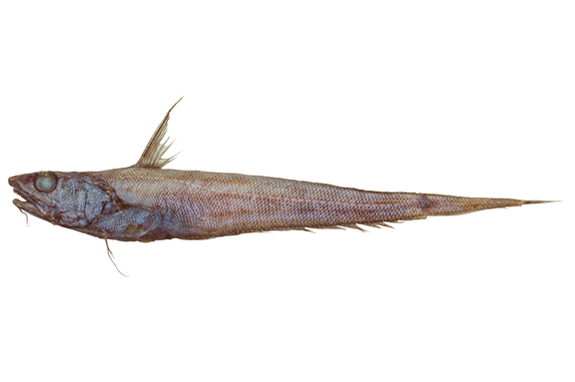Humpback Whiptail, Coryphaenoides dossenus McMillan 1999

Humpback Whiptail, Coryphaenoides dossenus. Source: Ken Graham / NSW Fisheries. License: All rights reserved
The Humpback Whiptail has a distinct hump behind the head in large specimens, a large mouth that extends to the rear end of the eye and a low snout that barely protrudes beyond the upper jaw in females, and protrudes only slightly in males. The chin barbel is long, measuring about 1/5th to 2/3rds the length of the head. Pelvic 8 (rarely 7 or 9) rays. The chin barbel is long (up to one-third the head length). The species is sexually dimorphic and large females have a pronounced hump behind the head and grow to a larger size than males.
Humpback Whiptail, Coryphaenoides dossenus McMillan 1999
More Info
|
Distribution |
Widespread in tropical and temperate waters of the Southern Hemisphere from the eastern South Atlantic, southern Africa, across Indian Ocean to the Tasman and Coral Seas, Australia, New Zealand, New Caledonia and Vanuatu. In Australian waters, the Humpback Whiptail is known from the Coral Sea off Queensland, south to off southern Tasmania and the South Tasman Rise, and westwards to off southwestern Australia. The species is bathydemersal in 670-1600 m in Australian waters and is frequently taken at 700-1200 m off New South Wales. |
|
Features |
Meristic characters: Dorsal-fin II, 9-11; Pectoral fin 17-24; Pelvic fin 8 (rarely 7 or 9); Gill rakers 11-13; Branchiostegal rays 6; Pyloric caecae 10-18 Head long, shallow, without prominent ridges and lacking enlarged, thickened scales; snout low, rounded to bluntly pointed, scarcely protruding beyond upper jaw, ventral margin of snout and suborbital region mostly naked; suborbital region flat, near vertical; mouth large, upper jaw reaching to about rear of orbit, eye small, shorter than snout; chin barbel long, outer gill slit not restricted. Leading edge of second spinous dorsal fin ray serrate, outer ray of pelvic fin somewhat elongate, barely or not reaching anal fin origin. Body scales large, strongly adherent, densely covered with small needle-like spinules. Anus immediately before anal fin origin, light organ absent. Mature females deep-bodied with pronounced hump on nape, males considerably smaller, with shallower, more elongated body and no hump. |
|
Size |
Females are much larger than males, reaching more than 85 cm TL; males grow to 50 cm TL. |
|
Colour |
The colour varies from a uniform pale whitish-grey to dark; fins dusky to blackish, anal fin sometimes darkly pigmented along outer margin; mouth and gill cavities dark. |
|
Feeding |
Unknown. |
|
Biology |
Little is known of the biology of the Humpback Whiptail.The species is sexually dimorphic. Males are much smaller than the females and have slender, elongate bodies and lack the pronounced hump of females. Fertilisation is external. |
|
Fisheries |
Although of no commercial importance, the Humpback Whiptail is frequently taken as bycatch in small numbers off New South Wales in 695-1200 m. Females are captured more often than the smaller males. |
|
Conservation |
Not assessed. |
|
Remarks |
The other names used for the Humpback Whiptail refer to the long chin barbel of this species. |
|
Similar Species |
The Humpback Whiptail may be confused with the deeper living Coryphaenoides armatus and C. rudis. C. armatus differs in having a the underside of the head mostly naked, usually 11 or 12 pelvic-fin rays and a shorter barbel (11-19% HL). C. rudis has a higher pelvic-fin ray count (9-11, usually 10), a shorter barbel, a larger interorbital space and a darker body coloration. |
|
Etymology |
The name dossenus is from Latin, meaning humpback, in reference to the prominent bulge on the body in front of the dorsal fin in large females. |
|
Species Citation |
Coryphaenoides dossenus McMillan, 1999, N. Z. J. Mar. Freshwater Res. 33: 482, figs. 1-2, Challenger Plateau, 41°2.0'S, 169°30.3'E, 908-910 m. |
|
Author |
Dianne J. Bray |
Humpback Whiptail, Coryphaenoides dossenus McMillan 1999
References
Bray, D.J., D.F. Hoese, J.R. Paxton & J.E. Gates 2006. Macrouridae. pp. 581-607 in Beesley, P.L. & Wells, A. (eds). Zoological Catalogue of Australia. Volume 35 Australia : ABRS & CSIRO Publishing Parts 1-3 2178 pp.
Iwamoto, T. & Graham, K.J. 2001. Grenadiers (Families Bathygadidae and Macrouridae, Gadiformes, Pisces) of New South Wales, Australia. Proc. Calif. Acad. Sci. 52(21): 407-509, figs. 1-114.
Iwamoto, T. & McMillan, P.J. 2008. Family Macrouridae. pp. 320-347 in Gomon. M.F., Bray, D.J. & Kuiter, R.H (eds). Fishes of Australia's Southern Coast. Sydney : Reed New Holland 928 pp.
Iwamoto, T., Yu.N. Shcherbachev & B. Marquardt. 2004. Grenadiers (Gadiformes, Teleostei) of Walters Shoals, southwestern Indian Ocean, with description of a new "west-wind drift" species. Proceedings of the California Academy of Sciences 55(10): 190-207.
McMillan, P. 1994. Family Macrouridae, In Gomon, MF, C.J.M. Glover & R.H. Kuiter. The fishes of Australia's south coast. State Print, Adelaide. 992 pp.
McMillan, P.J. 1999. New grenadier fishes of the genus Coryphaenoides (Pisces: Macrouridae); one from off New Zealand and one widespread in the southern Indo-West Pacific and Atlantic Oceans. New Zealand Journal of Marine and Freshwater Research 33: 481-489.
Merrett, N.R. & T. Iwamoto. 2000. Pisces Gadiformes: Grenadier fishes of the New Caledonian region, southwest Pacific Ocean. Taxonomy and distribution, with ecological notes, pp. 723-781 In Crosnier, R. (ed). Résultats des Campagnes MUSORSTOM, 21. Mem. Mus. Natl. Hist. Nat. 184.
Shcherbachev, Y.N. & T. Iwamoto. 1995. Indian Ocean grenadiers of the subgenus Coryphaenoides, genus Coryphaenoides (Macrouridae, Gadiformes, Pisces). Proc. Acad. Calif. Sci. 48(3): 97-108, figs. 1-9.

